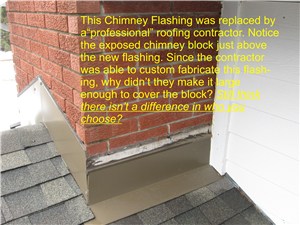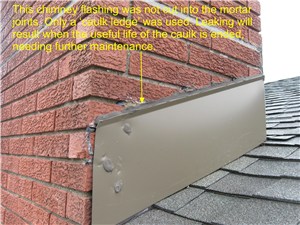Poor workmanship on Brookfield, WI chimney flashing!
 We recently visit a Brookfield, WI residence in the Le Chateau subdivision. We had worked on several homes in the area. This homeowner had actually stopped at a jobsite we were working on right around the corner from his house. He was interested in our roof and gutter ice dam prevention system. We eventually installed one on his house, too. While working on the roof, we noticed poor workmanship in several visible areas. When we see poor workmanship so easily visible, we always wonder what was done where we can’t see (like ice and water barrier, hidden flashing, proper soffit ventilation, etc.). This blog will cover this chimney flashing. We will walk you through our observations as an illustration of what to look for and ask when considering this type of work.
We recently visit a Brookfield, WI residence in the Le Chateau subdivision. We had worked on several homes in the area. This homeowner had actually stopped at a jobsite we were working on right around the corner from his house. He was interested in our roof and gutter ice dam prevention system. We eventually installed one on his house, too. While working on the roof, we noticed poor workmanship in several visible areas. When we see poor workmanship so easily visible, we always wonder what was done where we can’t see (like ice and water barrier, hidden flashing, proper soffit ventilation, etc.). This blog will cover this chimney flashing. We will walk you through our observations as an illustration of what to look for and ask when considering this type of work.
First of all, the material used. They did this right. This is commercial grade prefinished steel (medium bronze is the color). They also (at least on the sloped side) installed the flashing as a two piece system. This is important because masonry chimneys do not move with the normal expansion and contraction (as well as settling) that wood framed structures do. The two piece design allows for that movement. One piece designs (like you see on the face of the chimney, below the writing) do not allow for this movement. Typically, we see this with chimney flashings done by HVAC contractors hired to do this roofing work. However, on this one, it was done by a full service roofing contractor. Ask to see pictures of their work, not just a reference or two. You can also see in the picture above that the base flashing on the face does not even cover the chimney block (the light colored area below the brick). This roofing contractor fabricated the flashing – couldn’t he even measure properly or redo the flashing when he realized it wasn’t right.
 Notice, also, that the flashing was not cut into the mortar joints. This means that the entire waterproofing the flashing is providing is dependent on the caulking itself. Caulking is something that needs to be maintained – perhaps every 5-10 years. This flashing should be cut into the chimney. This is known as a reglet cut. It is our common practice to cut a groove into the mortar joint or brick that is about 1.25″ deep. This allows for the top portion of the flashing to be embedded in the chimney. We also have a reverse bend, known as a reglet bend, on the top portion which mechanically locks the flashing into the chimney. While we do use sealant to finish everything off, this reglet bend waterproofs the flashing to the chimney. You can also see the shoddy workmanship around the fasteners. The hammer marks are evidence of an unskilled worker trying to fasten this flashing in place. We are sure the customer did not pay for this level of craftsmanship or for somebody to be learning on the job.
Notice, also, that the flashing was not cut into the mortar joints. This means that the entire waterproofing the flashing is providing is dependent on the caulking itself. Caulking is something that needs to be maintained – perhaps every 5-10 years. This flashing should be cut into the chimney. This is known as a reglet cut. It is our common practice to cut a groove into the mortar joint or brick that is about 1.25″ deep. This allows for the top portion of the flashing to be embedded in the chimney. We also have a reverse bend, known as a reglet bend, on the top portion which mechanically locks the flashing into the chimney. While we do use sealant to finish everything off, this reglet bend waterproofs the flashing to the chimney. You can also see the shoddy workmanship around the fasteners. The hammer marks are evidence of an unskilled worker trying to fasten this flashing in place. We are sure the customer did not pay for this level of craftsmanship or for somebody to be learning on the job.
 While the flashing was hemmed at the top (at the caulk ledge) it was not hemmed at the bottom. Why is hemming so important on metal flashing? A hem, or the doubling over of the metal edge, protects the unfinished edge from corrosion. It also stiffens the metal panel itself. It is our standard practice to hem edges of the metal and the standard practice in the sheet metal industry. Apparently, this contractor must have been too rushed to take the couple of minutes necessary to hem the bottom edges. The ‘kicker’ tin is missing as well. This is a flashing that diverts the water away from the chimney into the gutter. It is a very easy thing to do, but many contractors leave this extra step out.
While the flashing was hemmed at the top (at the caulk ledge) it was not hemmed at the bottom. Why is hemming so important on metal flashing? A hem, or the doubling over of the metal edge, protects the unfinished edge from corrosion. It also stiffens the metal panel itself. It is our standard practice to hem edges of the metal and the standard practice in the sheet metal industry. Apparently, this contractor must have been too rushed to take the couple of minutes necessary to hem the bottom edges. The ‘kicker’ tin is missing as well. This is a flashing that diverts the water away from the chimney into the gutter. It is a very easy thing to do, but many contractors leave this extra step out.
The reason for this new chimney flashing was to repair an old chimney flashing. It was suggested by the roofing contractor after he had already done the roof. This suggestion should have been made at the time of roof replacement. Doesn’t look like this repair will last very long. The caulk will wear out and the leaking will return. In our next posting we will feature other areas on the house where short cuts were taken. Our discussion with the customer led us to believe they were unaware of these ‘short cuts’.
Protect yourself from inferior sheet metal flashing work.
Ask questions on how the contractor will handle the details like sheet metal flashings, chimney flashings, and wall flashings. Ask to see pictures of this type of work. If he does it well, his pride will show and he will show you pictures (and not just of roofs from a distance, actual sheet metal flashings he has installed). Ask him if they plan on replacing the flashings with the new roof. They absolutely should. If they aren’t going to, cross them off your list. If you want our help with the flashing portion of your project, give us a call or contact us. We will be happy to assist you.